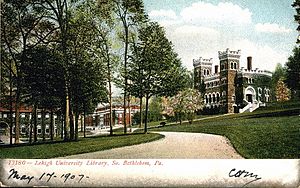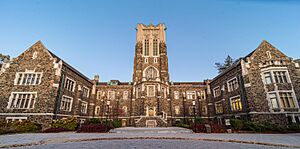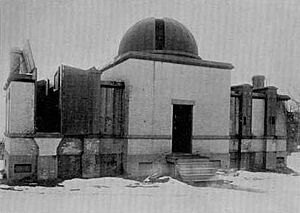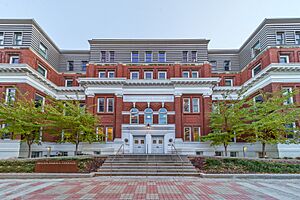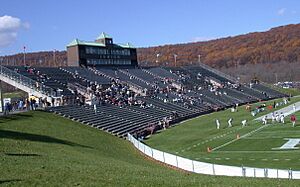Lehigh University facts for kids
 |
|
| Motto | Homo minister et interpres naturae (Latin) |
|---|---|
|
Motto in English
|
"Man, the servant and interpreter of nature" |
| Type | Private research university |
| Established | July 27, 1865 |
| Founder | Asa Packer |
| Accreditation | MSCHE |
|
Religious affiliation
|
Nonsectarian; historically Episcopal Church |
|
Academic affiliations
|
|
| Endowment | $2.20 billion (2024) |
| President | Joseph J. Helble |
| Provost | Nathan Urban |
|
Academic staff
|
681 (2023) |
|
Total staff
|
1,997 (2023) |
| Students | 7,692 |
| Undergraduates | 5,911 |
| Postgraduates | 1,781 |
| Location |
,
,
United States
40°36′22″N 75°22′38″W / 40.60611°N 75.37722°W |
| Campus | Small city, 2,350 acres (950 ha) |
| Newspaper | The Brown and White |
| Colors | Brown and white |
| Nickname | Mountain Hawks |
|
Sporting affiliations
|
|
| Mascot | Clutch the Mountain Hawk |
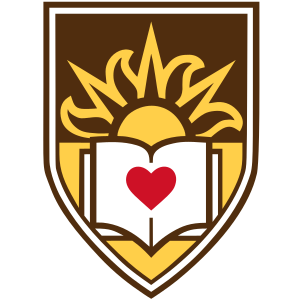 |
|
Lehigh University (often called LU) is a private research university in Bethlehem, Pennsylvania, United States. A businessman named Asa Packer started the university in 1865. Since the 1971–72 school year, both boys and girls have attended Lehigh's undergraduate programs. In 2022, Lehigh had about 5,911 undergraduate students and 1,781 graduate students.
Lehigh University has five main colleges. These are the P.C. Rossin College of Engineering and Applied Science, the College of Arts and Sciences, the College of Business, the College of Education, and the College of Health. The College of Arts and Sciences is the biggest, with 38% of all students. The university offers many types of degrees, from bachelor's to doctorates. Lehigh is known as a "Doctoral University R1," which means it does a lot of important research.
Contents
Exploring Lehigh's Campuses
Lehigh University is located in Bethlehem, Pennsylvania. This area is known as the Lehigh Valley and has a history of industry. The university covers about 2,350 acres, which includes sports fields and many buildings.
The university is built on and around South Mountain. It has three connected campuses:
- The Asa Packer Campus: This is the original and main campus. It is built on the northern side of the mountain.
- The Mountaintop Campus: This campus is at the top of South Mountain. It has sports fields and important buildings like Iacocca Hall.
- The Murray H. Goodman Campus: This campus is just south of the others. It includes a large stadium with 16,000 seats and many sports facilities.
In 2012, Lehigh received a large gift of 755 acres of land. This gift helped the university grow to its current size. It also allows for future plans and new uses for the land.
How Lehigh University is Run
Lehigh University is a private school. This means it is managed by a group called the board of trustees. This board was created in 1866.
Student Leadership at Lehigh
In 1988, students at Lehigh created a student senate. This group helps represent undergraduate students. While they mostly give advice to the university's board, they decide which student clubs get money and become official. Graduate students also have their own separate student senate.
What Students Learn at Lehigh
In 2022, Lehigh had 584 full-time teachers. Most of these teachers (95%) have the highest degree in their field. The university uses a semester system for its classes. Students can enroll in undergraduate programs in all colleges except the College of Education.
Lehigh's Different Colleges
Lehigh University has five main colleges, each focusing on different subjects.
College of Arts and Sciences
This college is located in Maginnes Hall. It offers many courses in humanities, visual arts, and music. It has a marching band, a Wind Ensemble, and a Philharmonic orchestra. The Humanities Center hosts many literature and arts programs. Lehigh also has a program called ArtsLehigh to encourage interest in the arts.
College of Business
Lehigh started offering business and economics classes in 1893. The first economics professor, John L. Stewart, was hired in 1898. He is known for starting the College of Business in 1918. The first class in 1922 had only 77 students. By 1938, the college had about 10 professors and 350 students. It also started offering master's degrees in business.
College of Education
As of 2018, over 7,000 students have earned master's, doctoral, and other professional degrees from Lehigh's College of Education.
P.C. Rossin College of Engineering and Applied Science
Students who graduated from Lehigh's engineering college have invented important things like the escalator. They also founded companies like Packard Motor Car Company. Some graduates helped build the locks for the Panama Canal. Famous alumni include Roger Penske and Lee Iacocca. The engineering honor society, Tau Beta Pi, was also started at Lehigh.
College of Health
Lehigh's College of Health teaches about public health topics. These include biostatistics and how to use health data. This college opened on August 21, 2020. It was the first in the world to offer degrees in population health at all levels. It is based in the Health, Science, and Technology (HST) building, which opened in January 2022.
Getting into Lehigh University
Getting into Lehigh University is considered "more selective." This means it's a bit harder to get in. The Princeton Review gives Lehigh a high "Admissions Selectivity Rating" of 95 out of 99.
In 2024, Lehigh received over 20,000 applications. About 25% of students who applied were accepted. Of those accepted, about 28% chose to enroll. For students who submitted test scores, the middle 50% of SAT scores were between 1420 and 1520. ACT scores were between 32 and 35.
Lehigh University's Rankings
| ARWU World | 701–800 |
|---|---|
| THES World | 601–800 |
| USNWR National University | 46 |
| Washington Monthly National University | 29 |
| Forbes | 64 |
In 2024, The Wall Street Journal ranked Lehigh as the 14th best college in the U.S. This ranking looks at how well students do after graduation. U.S. News & World Report ranked Lehigh 46th among "National Universities" in 2025. It also ranked 25th for "Best Undergraduate Teaching" and 26th for "Best Value Schools."
Lehigh University was recognized in 2020 for its efforts in sustainability. It received an award for its part in the Solar Collaboration Project.
In 2024, The Princeton Review ranked Lehigh 1st for "Best Science Lab Facilities." It was also 10th for "Best College Library" and 15th for "Most Beautiful Campus." Lehigh also ranked 2nd for "Best College Newspaper" and 3rd for "Their Students Love These Colleges."
According to PayScale's 2024 report, Lehigh ranks 1st nationally for business majors based on how much they earn. Lehigh also ranks 12th among all universities for bachelor's degree salary potential.
In the 2024-2025 Forbes rankings, Lehigh was 64th overall among America's Top Colleges.
Lehigh University's College of Business was ranked 23rd in Poets&Quants' 2023 list of Best Undergraduate Business Schools. Its online MBA program was ranked 13th in 2025.
In 2023, U.S. News & World Report said Lehigh University's 1-MBA program was 5th in the U.S. for its salary-to-debt ratio. This means students earn a good salary compared to their student loan debt.
Student Life at Lehigh
Fraternities and Sororities
Many of Lehigh's social fraternities and sororities have their own houses on campus. These houses are mostly located on "The Hill." About 34% of undergraduate students are members of a fraternity or sorority. When new members join, this number goes up to almost 45%. There are 10 fraternities and eight sororities, all with houses on campus.
In the mid-1980s, Lehigh had many fraternities, but rules became stricter in the 1990s. Many groups had to close. Some of their old houses became sorority houses or new dorms.
Traditions and the School Newspaper
Lehigh's school colors are brown and white, chosen in 1874. The school newspaper, The Brown and White, has been published since 1894.
Lehigh University has many special traditions, especially during Spirit Week. This week leads up to the big Lehigh-Lafayette football game.
One fun tradition is the Bed Races. Teams of students decorate beds and race them down Packer Avenue. Students used to build their own beds to show off their engineering skills.
During Orientation Week, new students present their class flags at "The Rally." Each class gets an official flag passed down from the class that graduated 50 years before them. The oldest flag still around is from 1889.
The Lehigh-Lafayette football rivalry started in 1884. It is one of the most famous rivalries in college football. The two schools have played each other more times than any other rivalry in the country.
The Marching 97 band is also a big part of Le-Laf Week. They play traditional Lehigh fight songs as they march around campus. The "Eco-flame" tradition started in the 1970s when a professor invited the band to play for his class.
Campus events like Lehigh After Dark's carnival bring students together. These events help build a strong community spirit.
ROTC Program
Since 1919, Lehigh has had an Army Reserve Officers' Training Corps (ROTC) unit. This program helps students train to become officers in the U.S. Army. Their unit is called the Steel Battalion.
Sports at Lehigh
Lehigh is part of the Patriot League. It competes in 25 different NCAA Division I sports. In 2006, 97% of Lehigh's student-athletes graduated. This was one of the highest rates among all NCAA Division I schools. In 2002, Lehigh won an award for having the best graduation rate among Division I schools.
Many Lehigh graduates have gone on to play professional sports. They have played in the National Football League, Major League Baseball, and the National Basketball Association. Some have even won gold medals at the Olympic Games.

Basketball
Lehigh's men's basketball team made history in 2012. As a #15 seed in the NCAA tournament, they played against the #2 seed Duke Blue Devils. Lehigh was not expected to win, but thanks to player CJ McCollum, they upset Duke 75-70. This was only the sixth time a #15 seed had beaten a #2 seed.
Football
Lehigh University and Lafayette College are big rivals in sports. Their football teams have played each other over 160 times since 1884. This makes their game, known as The Rivalry, the most played in college football history. It is also the longest uninterrupted rivalry, as they have played every year since 1897. For their 150th game, they played in a sold-out Yankee Stadium in New York City.
The week before the game is full of traditions. Students decorate fraternity houses, have parties, and hold rallies. The Marching 97 band often performs in classes the Friday before the game.
Wrestling
Lehigh's wrestling team is one of its most famous sports programs. It started in 1910. Over the years, many Lehigh wrestlers have been named All-Americans. The team has often ranked among the top 20 nationally. In 2008, Pat Santoro became Lehigh's head wrestling coach. He was a two-time national champion himself.
Home wrestling matches take place in Leeman-Turner Arena at Grace Hall. This arena is known as "The Snake Pit" and has been home to Lehigh wrestling since 1942. In 2013, Grace Hall was updated to include the Caruso Wrestling Complex.
In March 2017, Lehigh wrestler Darian Cruz won the NCAA Division I national wrestling tournament. He was the first Lehigh national champion since Zach Rey won in 2011.
Lacrosse
Lehigh University has strong men's and women's lacrosse teams. Both teams compete at the Division I level in the Patriot League.
The men's lacrosse team has won four Patriot League Championships. In 2024, they won the championship game against Boston University 11–10. This win earned them a spot in the NCAA Tournament.
Campus Safety and the Clery Act
In 1990, the United States Congress passed a law called the Clery Act. This law requires colleges to share information about crimes that happen on their campuses. The law helps make sure that students and families have important safety information.
Famous People from Lehigh
Many notable people have attended or worked at Lehigh University. You can find a full list at List of Lehigh University people.
See also
 In Spanish: Universidad de Lehigh para niños
In Spanish: Universidad de Lehigh para niños
- Lehigh University Press


